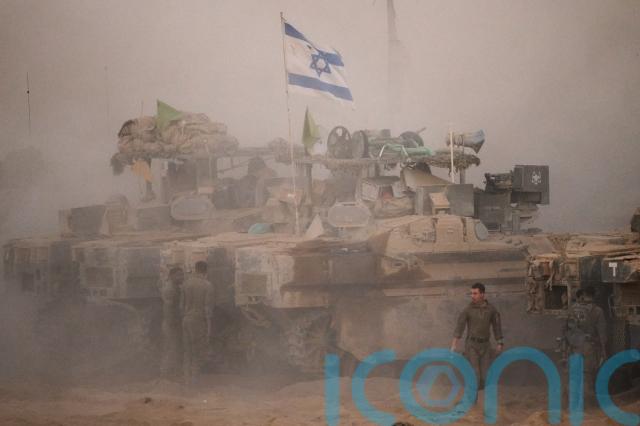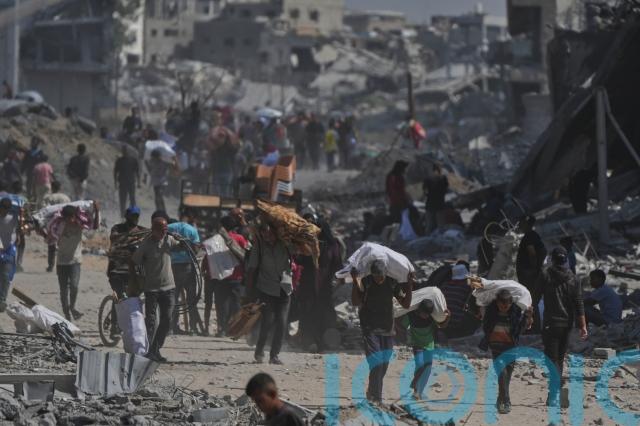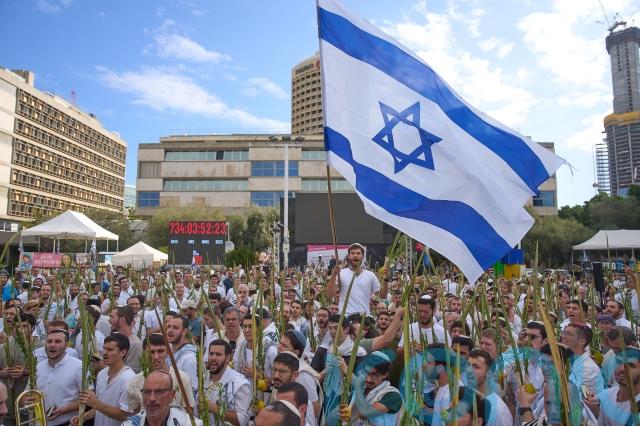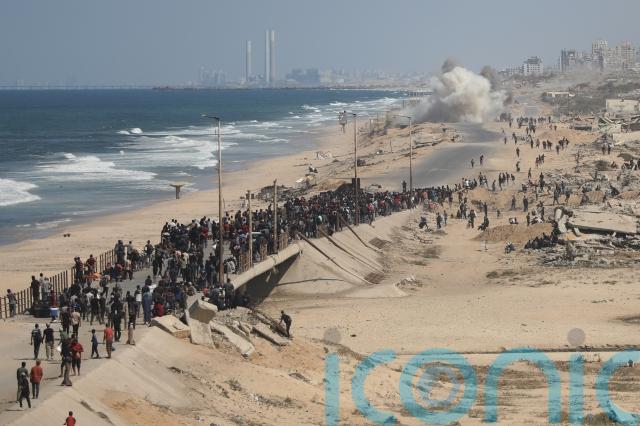
The Israeli military has said the ceasefire agreement with Hamas came into effect at noon local time (10am BST), and that troops have withdrawn to the agreed-upon deployment lines.
The announcement came after Palestinians reported heavy shelling on Friday morning in northern Gaza, hours after Israel’s Cabinet approved US President Donald Trump’s plan for a ceasefire in the Gaza Strip and the release of the remaining hostages and Palestinian prisoners.
Tens of thousands of people who had gathered in Wadi Gaza in central Gaza in the morning started walking north after the military’s announcement.
The approval marked a key step toward ending a ruinous two-year war that has destabilised the Middle East.
A brief statement from Israeli prime minister Benjamin Netanyahu’s office said the cabinet approved the “outline” of a deal to release the hostages, without mentioning other aspects of the plan that are more controversial.
A list published on Friday by Israel of Palestinian prisoners to be released as part of the deal does not include high-profile prisoner Marwan Barghouti, the most popular Palestinian leader and a potentially unifying figure.
Israel views Barghouti and some others as terrorist masterminds who murdered Israeli civilians and has refused to release them in past exchanges.

Mr Netanyahu said Israel is about to achieve one of its central goals in the two-year war – the return of the hostages.
“Hamas agreed to the deal only when it felt that the sword was on its neck — and it is still on its neck,” Mr Netanyahu said on Friday. “Hamas agreed to the deal after Trump’s plan, which I agreed to with the president in Washington.
“I promised the families of the hostages, and I also promised you, citizens of Israel, that we will return everyone, without exception. We promised and we are fulfilling it,” he said.
He insisted in the televised statement that the next stages would see Hamas disarm and Gaza demilitarised.
“If this is achieved the easy way, so be it. If not, it will be achieved the hard way,” Mr Netanyahu said.
Under the ceasefire plan agreed with Hamas, all 48 hostages still in captivity are expected to be released. Israel believes around 20 of them are alive.
A relative of one of the Israeli hostages believed to have died in captivity said the family hopes his body will be returned for burial as part of the Gaza ceasefire deal.
Stephen Brisley’s relative, Yossi Sharabi, is believed to have died in an airstrike in January 2024.
Mr Brisley’s sister and Yossi’s sister-in-law Lianne Sharabi, and her two teenage daughters were killed when Hamas militants attacked Israel on October 7 2023. His brother-in-law Eli Sharabi was taken hostage and subsequently released.
“It’s a measured sense of hope in all hostage families,” Mr Brisley told The Associated Press from his home in South Wales.
“It’s a guarded optimism because it’s the kind of optimism that’s born out of heartbreaking experience. We hold our hope lightly because we’ve had our hopes dashed before,” he said.
“It still feels like a long way between the announcement of the deal and actually getting Yossi’s body back to bury him.”
Steve Witkoff, Mr Trump’s top negotiator on the Gaza conflict, said the US military confirmed that Israeli soldiers have pulled back as part of the ceasefire agreement on Friday.
“The 72-hour period to release the hostages has begun,” Mr Witkoff wrote on social media on Friday morning.
In an interview with the Associated Press, the International Committee of the Red Cross (ICRC) says the expected hostage and prisoner release will be more challenging than previous ones given the scale and speed of the operation.
Christian Cardon, chief spokesman for the ICRC, said that while the group is expected to play a role as hostages are released from Gaza and Palestinian prisoners from Israel, it has not been given details in terms of when, how or where the releases would occur.
“Our colleagues are preparing themselves for all possible scenarios,” said Mr Cardon.
He said that the terms of the deal, which call for the hostages to be released from Gaza within 72 hours, was an “extremely” tight timeframe.
The ICRC was involved in prisoner and hostage releases in the two previous ceasefires during the war.
Mr Netanyahu added that Israel would continue with its demilitarisation of Hamas after the return of the hostages.
Israeli Brig Gen Effie Defrin, an Israeli military spokesman, said that troops had completed their withdrawal to the deployment lines by Friday afternoon, a few hours after the ceasefire officially went into effect.
An Israeli security official, speaking on condition of anonymity, earlier said the military would control around 50% of Gaza in their new positions.
In central Gaza’s Nuseirat refugee camp, Mahmoud Sharkawy, one of the many people sheltering there after being displaced from Gaza City, said artillery shelling had intensified in the early hours before the Israeli military began to withdraw.

A senior Hamas official and lead negotiator made a speech on Thursday laying out what he said were the core elements of the ceasefire deal: Israel releasing around 2,000 Palestinian prisoners, opening the border crossing with Egypt, allowing aid to flow and Israeli forces withdrawing.
Khalil al-Hayya said all women and children held in Israeli jails will also be freed. He did not offer details on the extent of the Israeli withdrawal from Gaza.
Al-Hayya said the Trump administration and mediators had given assurances that the war is over, and that Hamas and other Palestinian factions will now focus on achieving self-determination and establishing a Palestinian state.
“We declare today that we have reached an agreement to end the war and the aggression against our people,” Al-Hayya said in a televised speech on Thursday evening.
The hostage and prisoner releases are expected to begin on Monday, two Egyptian officials briefed on the talks and a Hamas official said, though another official said they could occur as early as Sunday night. The officials spoke on condition of anonymity because they were not authorised to be publicly named speaking about the negotiations.

All living hostages are expected to be released at the same time, followed by the bodies of the deceased, which could take more time.
Five border crossings are expected to reopen, including the Rafah crossing between Gaza and Egypt, the Egyptian and Hamas officials said. That will allow aid to flow into the territory, parts of which are experiencing famine.
Tom Fletcher, the UN humanitarian chief, told reporters on Thursday that officials have 170,000 metric tons of medicine, aid and other supplies at ready for transport into Gaza when they are given a green light.
The Trump plan calls for Israel to maintain an open-ended military presence inside Gaza, along its border with Israel. An international force, comprising largely of troops from Arab and Muslim countries, would be responsible for security inside Gaza.
To help support and monitor the ceasefire deal, US officials said they would send about 200 troops to Israel as part of a broader, international team. The officials spoke on condition of anonymity.
The US would also lead a massive internationally funded reconstruction effort.
The plan also envisions an eventual role for the Palestinian Authority — something Mr Netanyahu has long opposed. But it requires the authority, which administers parts of the West Bank, to undergo a sweeping reform programme that could take years.
The Trump plan is even more vague about a future Palestinian state, which Mr Netanyahu firmly rejects.
Speaking at a rally in northern Turkey, Turkish President Recep Tayyip Erdogan said a return to conflict would “come at a very high cost”.
“We are well aware of Israel’s poor track record when it comes to keeping its promises. They have broken their commitments using flimsy excuses and, unfortunately, betrayed the agreements they signed,” Mr Erdogan told the crowd.
“Returning to an environment of genocide would come at a very high cost.”
Turkey has frequently accused Israel of committing genocide in Gaza, an accusation Israel denies.
Mr Erdogan stressed the importance of swiftly getting humanitarian aid to Gaza, adding that Turkish ships were docked at a port in Egypt, waiting to deliver aid.
A steady stream of people, the vast majority on foot, crammed onto a coastal road in central Gaza, heading north to see what might have remained of their homes. Others headed to other parts of the Palestinian territory in the south.
“We want to go back,” said Fayez AlMajdoub, one of the crowd who had been displaced from northern Gaza. “I want to go and make sure my home is still there. That’s what I want to know.”
Another man displaced from northern Gaza, Jamal Mesbah, said: “My family is waiting, and we packed our stuff as we may return home. But we still suffered.
“There wasn’t much joy, but the ceasefire somewhat eased the pain of death and bloodshed, and the pain of our loved ones and brothers who suffered in this war.”
In Gaza’s southern city of Khan Younis, hundreds of Palestinians attempted to return to their homes, only to find wrecked buildings, rubble and destruction upon the withdrawal of the Israeli troops.
“There was nothing left. Just a few clothes, pieces of wood, and pots,” said Fatma Radwan, who was displaced from eastern Khan Younis. People were still trying to retrieve bodies from under the rubble, she added.

“We came to a place that is unidentifiable. An unidentifiable town. Destruction is everywhere,” said Hani Omran, who was also displaced from eastern Khan Younis.
The war began when Hamas-led militants stormed into Israel on October 7 2023, killing some 1,200 people and taking 251 hostage.
In Israel’s ensuing offensive, more than 67,000 Palestinians have been killed in Gaza and nearly 170,000 wounded, according to Gaza’s Health Ministry, which does not differentiate between civilians and combatants but says around half the deaths were women and children.
Subscribe or register today to discover more from DonegalLive.ie
Buy the e-paper of the Donegal Democrat, Donegal People's Press, Donegal Post and Inish Times here for instant access to Donegal's premier news titles.
Keep up with the latest news from Donegal with our daily newsletter featuring the most important stories of the day delivered to your inbox every evening at 5pm.